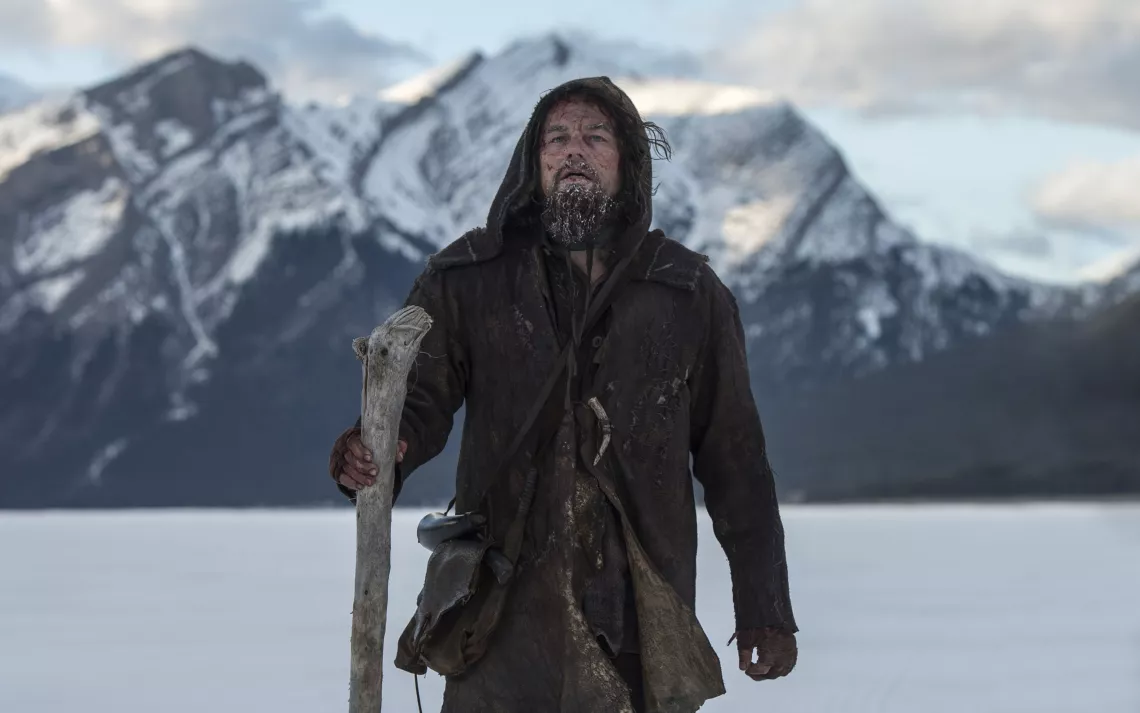In Review: The Revenant

Leonardo DiCaprio in The Revenant | Photo by Kimberley French
The scene opens with the sound of bones cracking, ribs breaking apart. We hear the tearing of frozen flesh. A man’s bloodied and bruised hand appears from within the darkness. Then his scarred arm. And then we see all of him, naked, crawling out from the inside of his own horse to a pine forest cloaked in new snow, the world as pristine as you could ever imagine. The symbolism is impossible to miss: This is a rebirth.
The sight of a man emerging from the carcass of a horse he’s used as an overnight shelter is just one of many dreamlike images that populate Alejandro G. Iñárritu’s epic western, The Revenant. Or, I should say, anti-western. Because in this haunting, beautiful new film, Oscar-winning director Iñárritu (Birdman, Babel, 21 Grams) has taken many of the tropes of that classic Hollywood genre and turned them inside out to create a dark fable of murder and revenge.
It’s 1823, and the trappers of the Rocky Mountain Fur Company are eager to get their beaver furs down the Missouri River so they can make a small fortune. A brutal, dawn attack by a band of Arikara Indians scuttles the plan and forces a small group of survivors to cache their pelts and head cross-country. The trappers’ chief scout is a legendary frontiersman, Hugh Glass (a bearded, grizzled Leonardo DiCaprio) and his half-Pawnee son. Everyone in the brigade acknowledge that without Glass’s woodcraft, they would be in worse trouble. It’s bad luck, then, when just a few days later a mama grizzly mauls Glass. The bear assault is CGI at its best: We can see the oil on the bear’s fur, the ripple of its powerful muscles as the animal tears Glass to shreds, leaving his back a tattered mess and his windpipe sliced open.
The trapper party is faced with a brutal Hobson’s choice: Either show Glass mercy and try to carry him to the nearest white outpost, but risk starvation or another Indian attack, or leave him in the woods, knowing that he’ll most likely die anyway. The brigade’s leader, Captain Andrew Henry (Domhnall Gleeson), tries to avoid the tough decision by paying two other trappers to stay with Glass and his son until Glass passes away. Enter the mean-spirited John Fitzgerald (an almost unrecognizable Tom Hardy) and the kind-hearted adolescent, Jim Bridger (Will Poulter). (History buffs will recognize one of those characters; Jim Bridger ultimately became one of the most famous trappers of the 19th century—the “King of the Mountain Men.”)
As we learn in the opening scene, Fitzgerald is a villain, and he wastes no time in wasting Glass’s son before the wounded man’s eyes, then tricking Bridger into believing an Arikara war party is on their trail and abandoning their wounded charge. The pair take Glass’s rifle and most of his kit and leave him for dead. That’s when the real action begins. Glass—badly wounded, famished, and fueled only by his anger and his loss—begins crawling his way across the wilderness to hunt down Fitzgerald and enact his revenge.
Incredibly, all of this is inspired by a true story. There was a real Hugh Glass, who really was a trapper mauled by a bear and left for dead, only to rise Lazarus-like from the wilds. It’s a ripping good yarn, and Iñárritu has no trouble fitting it into the Hollywood western archetype of the virtuous loner in combat against a wicked world. But Iñárritu is too smart a filmmaker to rest on old narratives. The whites are rapacious (“Would you rather hold onto those pelts or your life?” we hear one say after the opening battle), and we’re quick to wonder who the real savages are in this picture. At the same time, Iñárritu avoids the glib political correctness of Dances With Wolves. The most fully drawn Native Americans are a band of warriors who, just like Glass, are on a mission of vengeance. The Revenant brings to mind the morally ambiguous Unforgiven, Clint Eastwood’s adaptation of the brilliant David Peoples script. On the frontier, no one is innocent.
If the routine violence of the Old West seems shocking, it might be because it’s set against a landscape of such stunning beauty. The Revenant is, simply, a gorgeous film. In a preview earlier this year, an enviro website called The Revenant “a love letter to nature,” and I can’t improve on that description. Iñárritu and his cinematographer, Emmanuel Lubezki—a fellow Mexican and a two-time Oscar winner (Birdman, Gravity)—made the unorthodox decision to shoot the entire film using only natural light. Electrical lighting is key to the art of filmmaking, but it also contributes to an atmosphere of artifice that the audience can sometimes feel. It took extra work to make the natural world look, well, real. Lubezki pioneered a brand-new camera system, the Alexa 65, to soak in as much light as possible.
The technical effort pays off. With Lubezki’s tender treatment, the wilderness feels visceral and immediate—which is to say, as alive as it truly is. Again and again the camera lingers on the landscape. Lubezki is a connoisseur of light, and his lens savors wild nature’s ordinary miracles: the absinthe wash of the aurora borealis, the shadow-dance of a campfire, the Rocky Mountains spread out like a string of fangs. A dawn sun breaks through the trees and sparkles like a pincushion made of rainbows.
Leonardo DiCaprio’s strong performance amplifies the tension between the sublime scenery and the brutal, bloody action. Few Hollywood A-listers have DiCaprio’s knack for going feral. Sure, he’s a charming global ambassador with matinee idol looks, but some of his best performances have been in a primal register: the mentally retarded boy in What’s Eating Gilbert Grape, the poet Rimbaud, the drug addict Jim Carroll, Amsterdam Vallon in Gangs of New York, and the unhinged Howard Hughes. In The Revenant, DiCaprio takes feral as far as it can go. He grunts and growls most of his lines, and spends much of the film hunched on all fours. Glass becomes more animal than man. The savagery in his eyes has no hint of the noble search for justice.
Make no mistake: The Revenant is, in its own way, a message movie. The book on which the film is loosely based—historian Michael Punke’s poetry-bereft novel of the same name—carries the unambiguous title “A Novel of Revenge.” Iñárritu is equally explicit in his intentions. At one point, a Pawnee man who is on a similar quest lends assistance to the wounded Glass. The Pawnee man’s face is painted all white, like a member of a Greek chorus, and he warns Glass: “My heart bleeds. But revenge is in the Creator’s hands.”
Our hero ignores the advice. After one more blood-stained scene, his hunger for vengeance is finally sated. But his loss and his sadness remain undimmed.
The Revenant opens in select cities on Christmas Day, and nationwide in January. Rated R. Includes up-close-and-personal physical violence. Watch the trailer here.
 The Magazine of The Sierra Club
The Magazine of The Sierra Club



